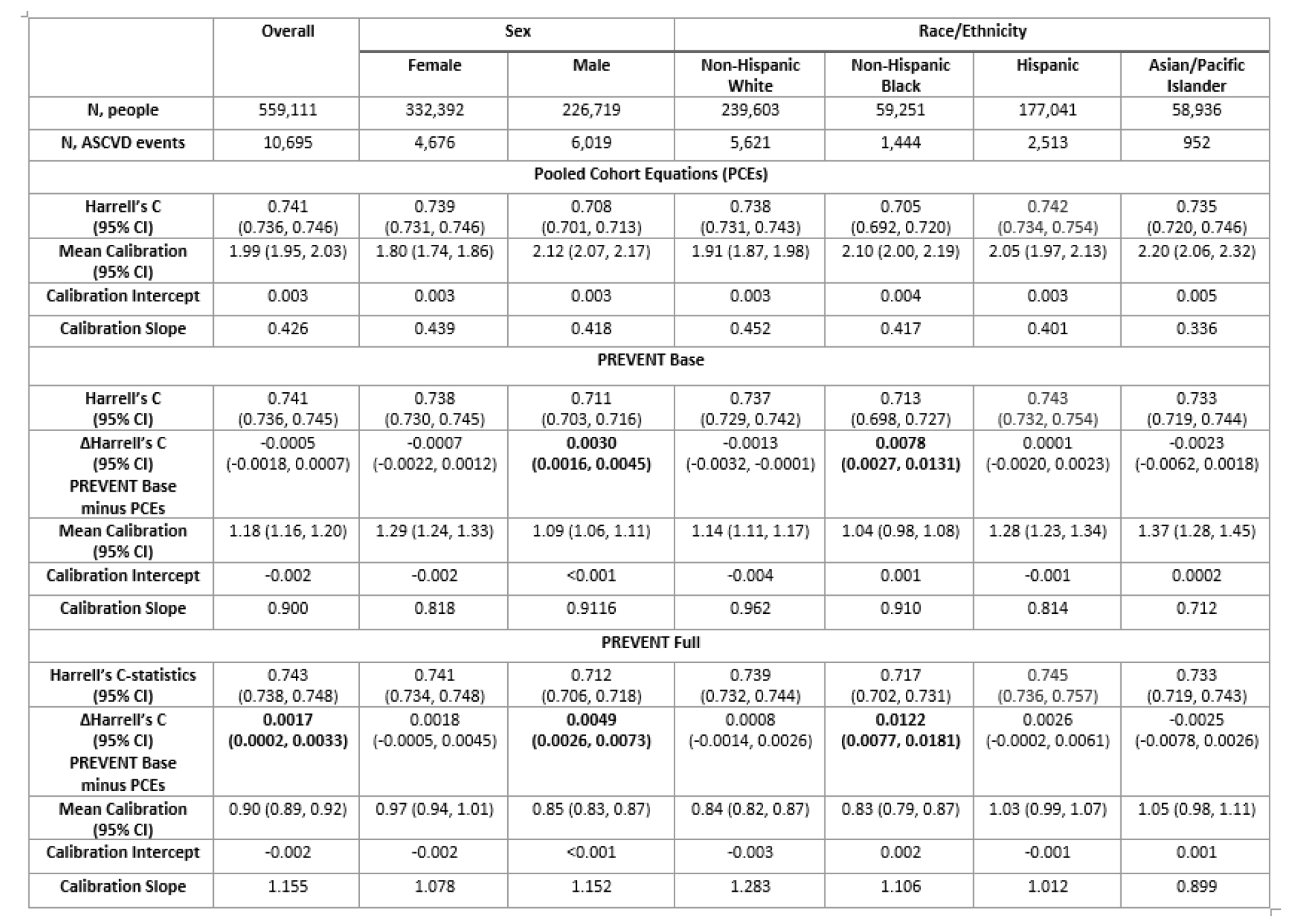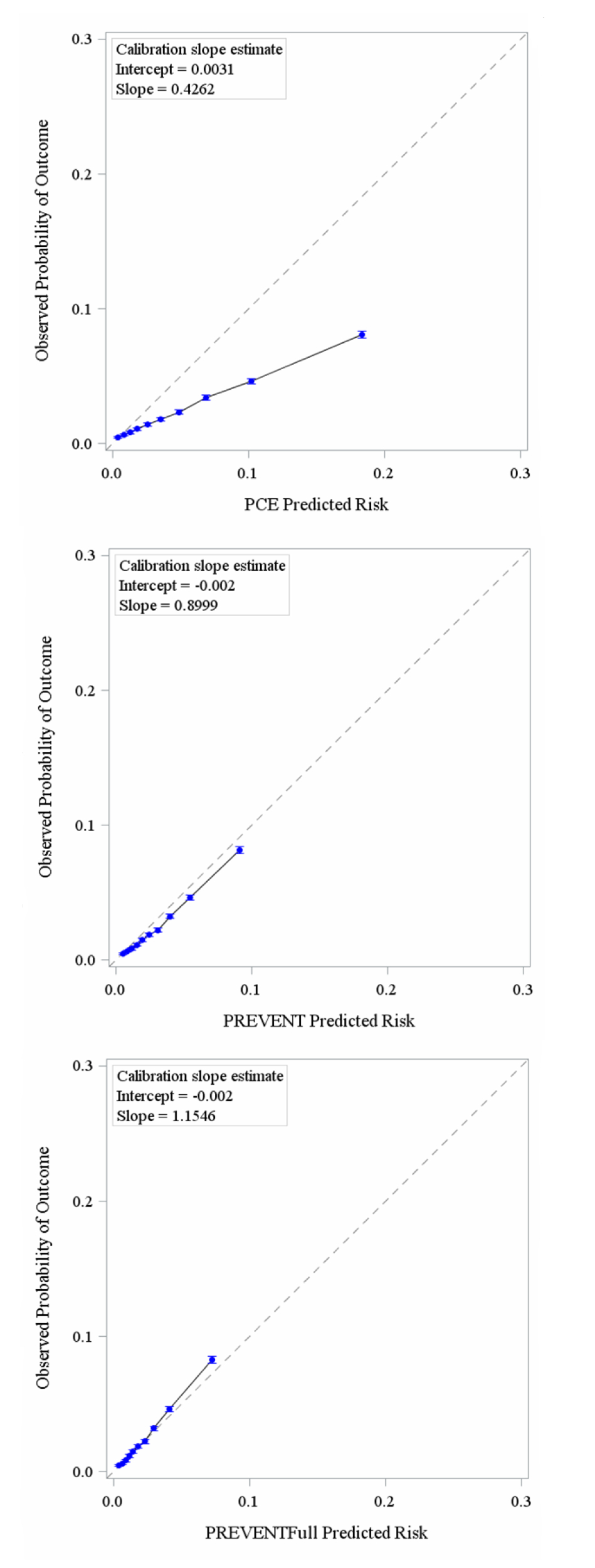Final ID: MDP429
Evaluation of 10-Year Atherosclerotic Cardiovascular Risk Prediction Performance using the PREVENT versus Pooled Cohort Equations in a US Integrated Healthcare System
Abstract Body (Do not enter title and authors here): Background: The American Heart Association published the new PREVENT equations for estimating atherosclerotic cardiovascular disease (ASCVD) risk.
Question: Do the PREVENT equations improve risk prediction for 10-year ASCVD compared with the pooled cohort equations (PCEs) in a large diverse population?
Aim: To assess ASCVD risk prediction performance of the two PREVENT equations [PREVENT Base, PREVENT Base plus optional predictors including urine albumin-to-creatinine ratio, glycated hemoglobin, and social deprivation index (PREVENT Full)] compared with the PCEs.
Methods: We included adults aged 40-75 years without a history of ASCVD or diabetes from Kaiser Permanente Southern California in 2009 and followed them through 2019. Outcome was incident ASCVD defined as myocardial infarction, fatal coronary heart disease, fatal and nonfatal stroke. We compared model discrimination (Harrell’s C), mean calibration (estimated as the ratio of predicted to observed event rates), and calibration curve among the overall population and stratified by sex and race/ethnicity.
Results: Of the 559,111 adults (mean age 54, 11% Black, 32% Hispanic), 10,695 developed an ASCVD event during a median follow-up of 10 years. Harrell’s C among the overall population was 0.741 (95% CI 0.736-0.745) for PREVENT Base, 0.743 (0.738-0.748) for PREVENT Full, and 0.741 (0.736-0.746) for the PCEs (Table). Compared with the PCEs, both PREVENT equations improved Harrell’s C in men but not in women, and in Black adults but not in other racial/ethnic groups. Both PREVENT equations were well-calibrated (mean calibration ranged 0.83-1.37; calibration slope ranged 0.71-1.28), while the PCEs overestimated 10-year ASCVD risk (mean calibration ranged 1.80-2.20; calibration slope ranged 0.34-0.45) (Table & Figure).
Conclusion: Compared with the PCEs, both PREVENT Base and Full equations improved calibration in predicting 10-year ASCVD risk, with minimal improvement in discrimination in men and Black adults only.
Question: Do the PREVENT equations improve risk prediction for 10-year ASCVD compared with the pooled cohort equations (PCEs) in a large diverse population?
Aim: To assess ASCVD risk prediction performance of the two PREVENT equations [PREVENT Base, PREVENT Base plus optional predictors including urine albumin-to-creatinine ratio, glycated hemoglobin, and social deprivation index (PREVENT Full)] compared with the PCEs.
Methods: We included adults aged 40-75 years without a history of ASCVD or diabetes from Kaiser Permanente Southern California in 2009 and followed them through 2019. Outcome was incident ASCVD defined as myocardial infarction, fatal coronary heart disease, fatal and nonfatal stroke. We compared model discrimination (Harrell’s C), mean calibration (estimated as the ratio of predicted to observed event rates), and calibration curve among the overall population and stratified by sex and race/ethnicity.
Results: Of the 559,111 adults (mean age 54, 11% Black, 32% Hispanic), 10,695 developed an ASCVD event during a median follow-up of 10 years. Harrell’s C among the overall population was 0.741 (95% CI 0.736-0.745) for PREVENT Base, 0.743 (0.738-0.748) for PREVENT Full, and 0.741 (0.736-0.746) for the PCEs (Table). Compared with the PCEs, both PREVENT equations improved Harrell’s C in men but not in women, and in Black adults but not in other racial/ethnic groups. Both PREVENT equations were well-calibrated (mean calibration ranged 0.83-1.37; calibration slope ranged 0.71-1.28), while the PCEs overestimated 10-year ASCVD risk (mean calibration ranged 1.80-2.20; calibration slope ranged 0.34-0.45) (Table & Figure).
Conclusion: Compared with the PCEs, both PREVENT Base and Full equations improved calibration in predicting 10-year ASCVD risk, with minimal improvement in discrimination in men and Black adults only.
More abstracts on this topic:
Age-Varying Implications of Recalibration of Cardiovascular Disease Risk Prediction in a New England-Based Healthcare System
Cho So Mi, Natarajan Pradeep, Rivera Rachel, Koyama Satoshi, Kim Min Seo, Honigberg Michael, Bhattacharya Romit, Paruchuri Kaavya, Allen Norrina, Hornsby Whitney
Activated CD8+HLA-DR+ T Cells as Immune Biomarkers of Metabolic Dysfunction and Cardiovascular Risk in PrediabetesAlrashed Fatema, Alsaeed Halemah, Alturaiki Wael, Akhter Nadeem, Alosaimi Bandar, Almutairi Saeedah, Mubarak Ayman, Al-mulla Fahd, Ahmad Rasheed


